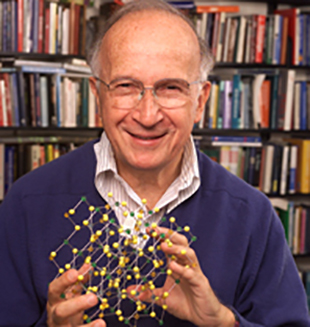

Roald Hoffmann (1937 )
“I love chemistry because it’s sort of human in scale--infinitely complex, but always tangible, always real.”
–Roald Hoffmann
National Medal of Science (NMS) recipient in 1983 for “His creative applications of theory to organic and inorganic chemistry have brought together the world community of chemists. The magnitude and uniqueness of his contributions to modern chemistry and the scientific process are contributing to an ever-improving understanding of chemistry.”
Roald Hoffmann was born Roald Safran in Zloczow Poland (now Ukraine). He was named after Roald Amundsen, the Norwegian explorer who led the expedition to discover the South Pole. Roald’s father, Hillel Safran, died in a Nazi labor camp, but Roald and his mother, Clara, escaped and were hidden in a schoolhouse attic for 15 months by a Ukranian teacher named Mikola Dyuk. Clara Safran remarried, and she and Roald took the last name Hoffmann. After moving around Europe for several years, the Hoffmann family came to the United States in 1949 and settled in Brooklyn, N.Y.
Hoffmann learned English, his sixth language, and attended Stuyvesant High School. His younger sister, Elinor, was born in 1954, and, a year later, Hoffmann graduated from high school and became a naturalized citizen. Although he was most interested in his humanities classes as an undergraduate at Columbia University and almost majored in art history, he ultimately focused on science because his family wanted him to be a doctor.
Hoffmann enjoyed his chemistry courses and began his graduate studies in chemical physics at Harvard University in 1958. While in graduate school, Hoffmann attended a summer program in Sweden and met Eva Börjesson, whom he married the following year.
After receiving his Ph.D., Hoffmann accepted a Junior fellowship at Harvard, where he developed a process for determining molecular orbitals called the extended Hückel method, and collaborated with fellow NMS recipient R.B. Woodward to develop a set of rules for predicting reactions, which eventually became known as the Woodward-Hoffmann rules.
In 1965, Hoffmann moved to Ithaca, N.Y., with his wife and their two children, Hillel Jan and Ingrid Helena, to join the faculty at Cornell University. He has remained at Cornell for the past four decades and is currently professor emeritus.
In 1981, Hoffmann received the Nobel Prize in chemistry for the theories he developed with Woodward on chemical reactions. Hoffmann shared the prize with Kenichi Fukui, who independently developed similar theories. Woodward, who had previously won the Nobel Prize in chemistry in 1965, was not eligible for the 1981 award as he had passed away several years prior.
Though Hoffmann is most well known for his work on chemical reactions and the extended Hückel method, he has said that teaching students, including the undergraduates in his first year general chemistry course, is his most significant contribution to the field. In addition to his traditional lecture courses, Hoffmann participated in “The World of Chemistry,” an introductory chemistry course that was filmed for television and has been shown widely since 1990.
“Science is a bridge between teaching and discovery,” Hoffmann said, “and my life has been spent building bridges.” Hoffmann has also revisited his lifelong passion for the humanities.
He has published five volumes of poetry and three plays, and helped organize a series of weekly ”Entertaining Science“ cabarets in Greenwich Village, in which performers present science mixed with music, art and spoken word.
“Both the scientific and the artistic ways of knowing...are important,” Hoffmann said. “Each adds to our understanding of the world within and around us.”
Image descriptions and credits
Any opinions, findings, conclusions or recommendations presented in this material are only those of the presenter grantee/researcher, author, or
agency employee; and do not necessarily reflect the views of the National Science Foundation.


